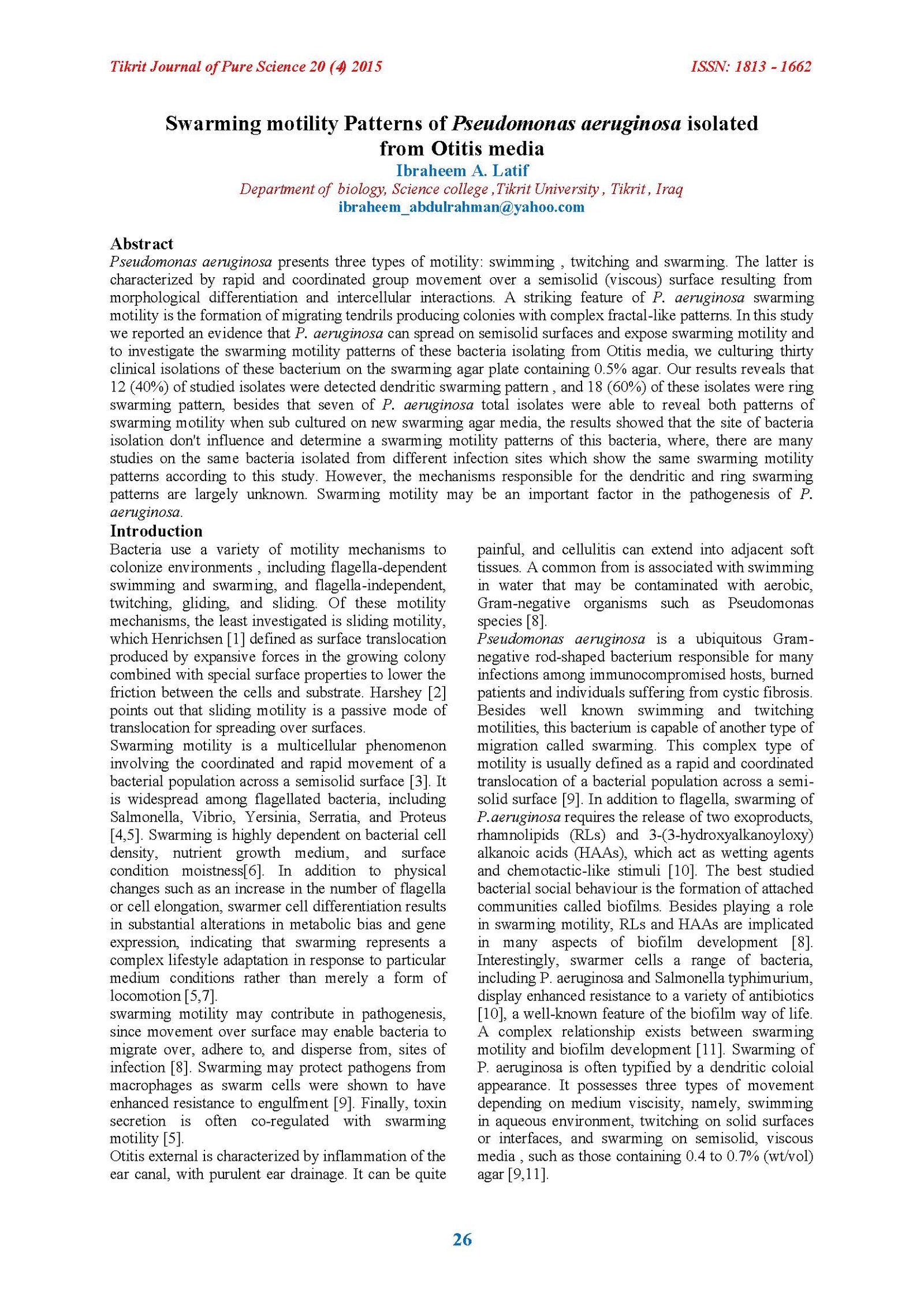Swarming motility Patterns of Pseudomonas aeruginosa isolated from Otitis media
Main Article Content
Abstract
Pseudomonas aeruginosa presents three types of motility: swimming , twitching and swarming. The latter is characterized by rapid and coordinated group movement over a semisolid (viscous) surface resulting from morphological differentiation and intercellular interactions. A striking feature of P. aeruginosa swarming motility is the formation of migrating tendrils producing colonies with complex fractal-like patterns. In this study we reported an evidence that P. aeruginosa can spread on semisolid surfaces and expose swarming motility and to investigate the swarming motility patterns of these bacteria isolating from Otitis media, we culturing thirty clinical isolations of these bacterium on the swarming agar plate containing 0.5% agar. Our results reveals that 12 (40%) of studied isolates were detected dendritic swarming pattern , and 18 (60%) of these isolates were ring swarming pattern, besides that seven of P. aeruginosa total isolates were able to reveal both patterns of swarming motility when sub cultured on new swarming agar media, the results showed that the site of bacteria isolation don't influence and determine a swarming motility patterns of this bacteria, where, there are many studies on the same bacteria isolated from different infection sites which show the same swarming motility patterns according to this study. However, the mechanisms responsible for the dendritic and ring swarming patterns are largely unknown. Swarming motility may be an important factor in the pathogenesis of P. aeruginosa.
Article Details

This work is licensed under a Creative Commons Attribution 4.0 International License.
Tikrit Journal of Pure Science is licensed under the Creative Commons Attribution 4.0 International License, which allows users to copy, create extracts, abstracts, and new works from the article, alter and revise the article, and make commercial use of the article (including reuse and/or resale of the article by commercial entities), provided the user gives appropriate credit (with a link to the formal publication through the relevant DOI), provides a link to the license, indicates if changes were made, and the licensor is not represented as endorsing the use made of the work. The authors hold the copyright for their published work on the Tikrit J. Pure Sci. website, while Tikrit J. Pure Sci. is responsible for appreciate citation of their work, which is released under CC-BY-4.0, enabling the unrestricted use, distribution, and reproduction of an article in any medium, provided that the original work is properly cited.
References
1. Overhage, J., Bains, M., Brazas, M.D., Hancock, R.E. Swarming of P. aeruginosa is a complex adaptation leading to increased production of virulence factors and antibiotic resistance. Journal of bacteriolgy. 2008;190(8): 2671-2679.
2. Harshey RM: Bacterial motility on a surface : Many ways to a common goal. Annus Rev Microbial 2003, 57:249-273.
3. Fraser, G. M., and C. Hughes. Swarming motility. Curr. Opin. Micribiol. 1999.2:630-635.
4. Daniels,R., J. Vanderleyden, and, J. Michiels. Quorum sensing and swarming migration in bacteria. FEMS Microbiol. 2004. Rev. 28:261-259.
5. Wang, Q.,J.G. Frye, M. McClelland, and R.M. Harshley. Gene expression patterns during swarming in Salmonella typhimurium: gene specific to surface growth and putative new motility and pathogenicity .2004. Mol. Microbiol. 52:169-187.
6. Rather, P.N. Swarming cell differentiation in proteus mirabilis. Environ. Microbiol. 2005. 7:1065-1073.
7. Calegan MC, Novosad BD, Ramtrez R,Ghelardi E, Senesi S. Role of swarming migration in the pathogenesis of Bacillus endopathalmitis. Investing. Opthalmol. Vis. Sci. 2006; 47:4461-4467.
8. Givskov M, Eberl L, Christiansen G, Benedik MJ S. Induction of phospholipase- and flagellar synthesis in Serratia liquefaciens is controlled by expression of the flagellar master operon flhD. Mol. Microbiolx. 1995; 145:445-454.
9. Sherris, J.C., Ryan, J.K., Ray, G.C. Medical Microbiology. 4th edition McGraw-Hill. 2004. p.890.
10. Vandepitte, J., Verhaegen, J., Engbaek, K., Rohner, P., Piot, P., Heuck, C.C. Basic laboratory procedures in clinical bacteriology. 2ed edition . World Health organization. Genera. 2003.
11. Lattuda, C.P., Mcnamara, A.M., Mageau, R.P., Green, S.S. Microbiology laboratory guide book. 3th edition. MLG, Science .1998.
12. Fobes, B.A., Sahm, F.D., Weissfeld, S.A. Diagnostic Microbiology. 11th edition. Mosby. 2002, 385-397
13. Fraser GM, Hughes C: Swarming motility. Curr Opin Microbiol. 1999, 2(6) 630-635.
14. Kohler T,Curty LK, Barja F, van Delden C, Pechere JC: Swarming of P. aeruginosa is dependent on cell signaling and requires flagella and pili. J. Bacterial. 2000,182(21) :5990-5996.
15. Tremblay J, Richardson A-P, Lepine F, Deziel E: Self- produced extracellular stimuli modulate the P. aeruginosa swarming motility behaviour. Environ Microbiol. 2007,9(10):2622-2630.
16. Davey ME, Caiazza NC, OToole GA: Rhamnolipid surfactant production affects biofilm architecture in P. aeruginosa PAO1. J. Bacterial 2003,185(3): 1027-1036.
17. Pamp SJ, Tolier-Nielsen T: Multiple roles of biosurfactants in structural biofilm development by P. aeruginosa . J. Bacterial 2007,189(6):2531-2539.
18. Lai S, Tremblay J, Deziel E: Sawrming motility: a multicellular behavior conferring antimicrobial resistance. Environ Microbiol 2009, 11(1): 126-136.
19. Butler MT, Wang Q, Harshey RM: Cell density and mobility protect swarming bacteria against antibiotics. Proc Natl Acad Sci USA 107(8): 3776-3781.
20. Merritt JH, Brothers KM, Kuchma SL, O Toole GA: Sadc reciprocally influences biofilm formation and swarming motility via modulation of exopolysaccharide production and flagellar function. J Bacteriol ,2007,189(22): 8154-8164.
21. Rajan, S., and L. Saiman . Pulmonary infections in patients with cystic fibrosis. Semin. Respir. Infect. 2002, 17:47-56.
22. Tinaz, G.B., Ulusoy, S. Charcterization of N-butanyol L-homoserine lactone (C4-HSL) deficient clinical isolates of P. aeruginosa. Microbial pathogensis. 2008; 44:13-19.
